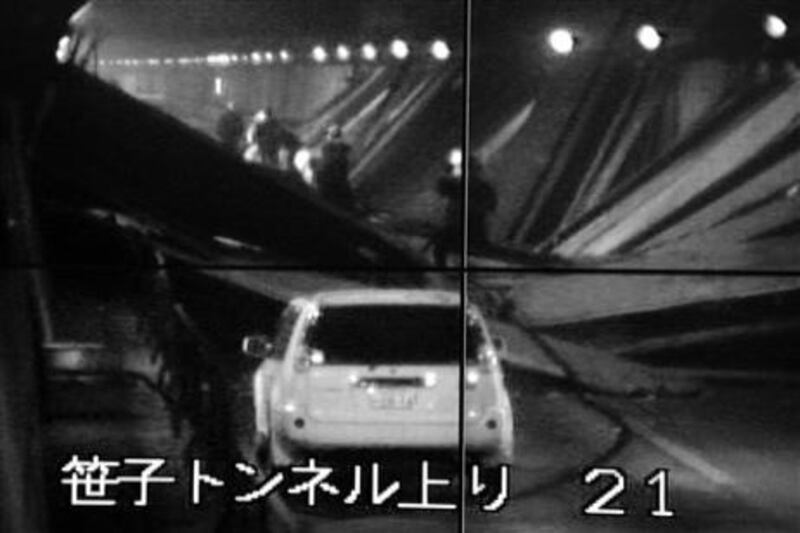KOSHU // Japanese rescuers found several charred bodies in a highway tunnel that collapsed today, crushing cars and triggering a blaze, and sparking fears of another cave-in.
At least seven people were missing inside the nearly five-kilometre (three mile)-long tunnel. Witnesses spoke of terrifying scenes as one vehicle burst into flames, sending out clouds of blinding, acrid smoke.
Rescuers were forced to suspend for several hours their efforts to reach those believed trapped under thick concrete ceiling panels that crashed from the roof of the tunnel, as engineers warned more debris could fall.
Emergency crews who rushed to the Sasago tunnel on the Chuo Expressway, 80 kilometres (50 miles) west of the capital, were hampered by thick smoke billowing from the entrance.
Dozens of people abandoned their vehicles on the Tokyo-bound section of carriageway, and ran for one of the emergency exits or for the mouth, where they huddled in bitter winter weather.
Emergency crews equipped with breathing apparatus battled around a third of the way into the tunnel, where they found up to 70 metres of concrete panels had come crashing down, crushing at least two vehicles.
Hours after the collapse, engineers warned the structure could be unstable, forcing resucers to suspend their work as a team of experts assessed the danger.
It was during this inspection that accompanying police officers confirmed the first deaths.
"What we found resembled bodies inside a vehicle, they were blackened. We have visually confirmed them but have yet to take them out for closer examination," an official told AFP.
The rescue operation resumed several hours later, an AFP reporter witnessed.
Cameras inside the tunnel earlier showed an ambulance and several firefighters wearing protective gear, working in a section where cars sat with their lights flashing, shrouded in smoke.
"According to information from local fire authorities, seven people are missing but the number has not been confirmed," an official at the government's Fire and Disaster Management Agency told AFP.
At least three people were taken to hospital, including one 28-year-old woman who emerged from the smoke-darkened tunnel by herself.
The woman told the fire rescue unit she had been travelling in a rented van with five other people, fire department official Kazuya Tezuka told AFP by telephone.
"I have no idea about what happened to the five others. I don't know how many vehicles were ahead and behind ours," she was quoted as saying.
A truck driver who managed to telephone a colleague from inside the tunnel was also believed to be trapped and emergency services said they were on their way to get him.
An AFP reporter at the scene said two large orange emergency structures had been erected at the tunnel mouth and a helicopter remained nearby, apparently ready to ferry the injured to hospital.
The tunnel, which passes through hills not far from Mount Fuji, is one of the longest in Japan. It sits on a major road connecting Tokyo with the centre and west of the country.
A reporter for NHK said he was passing through the tunnel on his way to Tokyo when it started to disintegrate.
"I managed to drive through the tunnel but vehicles nearby appeared to have been trapped," he said. "Black smoke was coming and there seemed to be a fire inside the tunnel."
A man in his 30s, who was just 50 metres (yards) ahead of the caved-in spot when the incident happened, recounted details of the terrifying experience.
"A concrete part of the ceiling fell off all of a sudden when I was driving inside. I saw a fire coming from a crushed car. I was so frightened I got out of my car right away and walked one hour to get outside," he told NHK.
Japan has an extensive and well-maintained network of highways throughout its mountainous terrain, with thousands of tunnels, usually several hundred metres long. Millions of cars use the network every day.
sps-hih-oh/hg/sls





